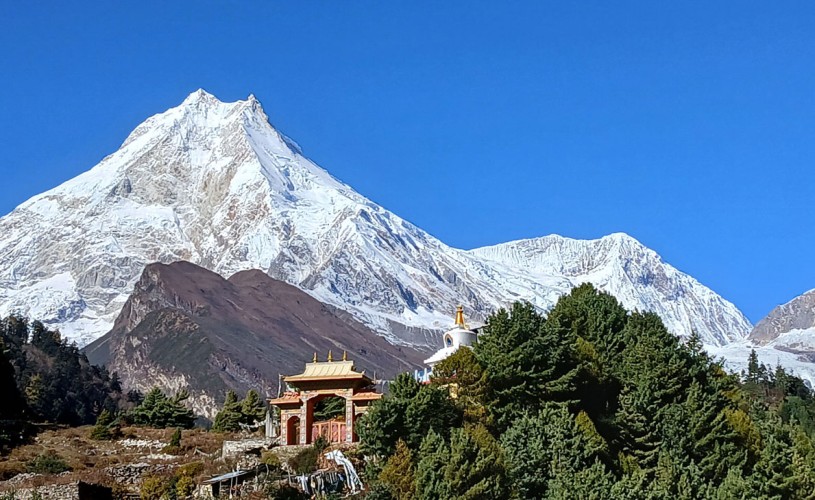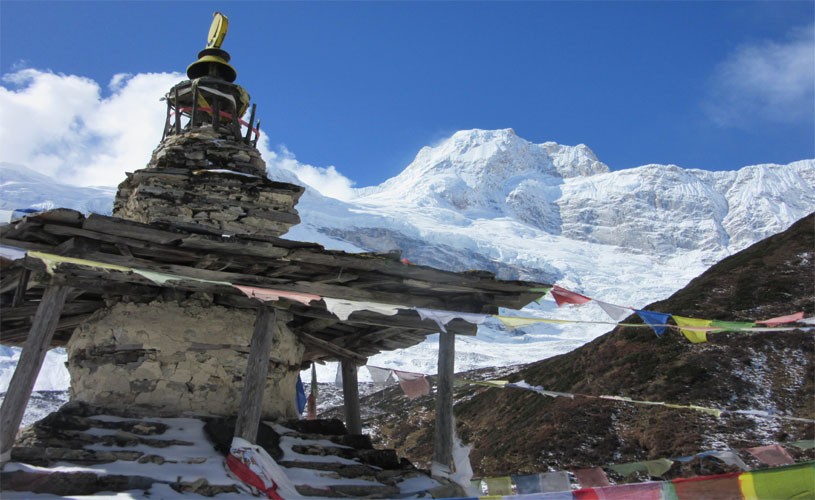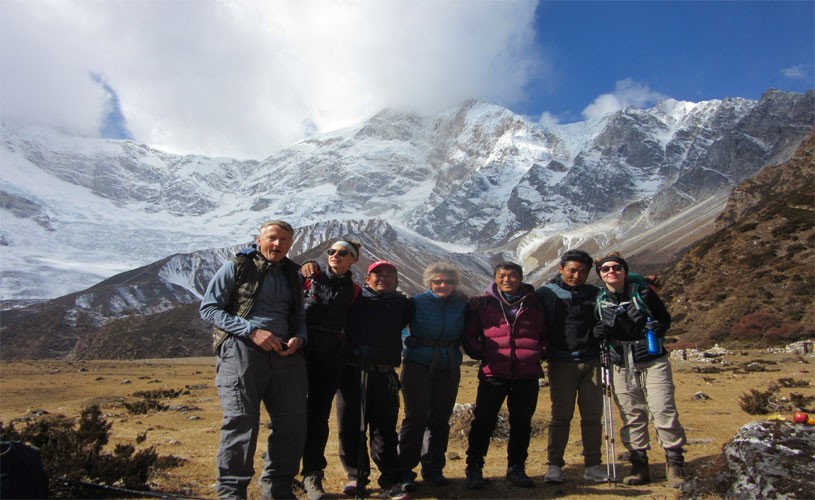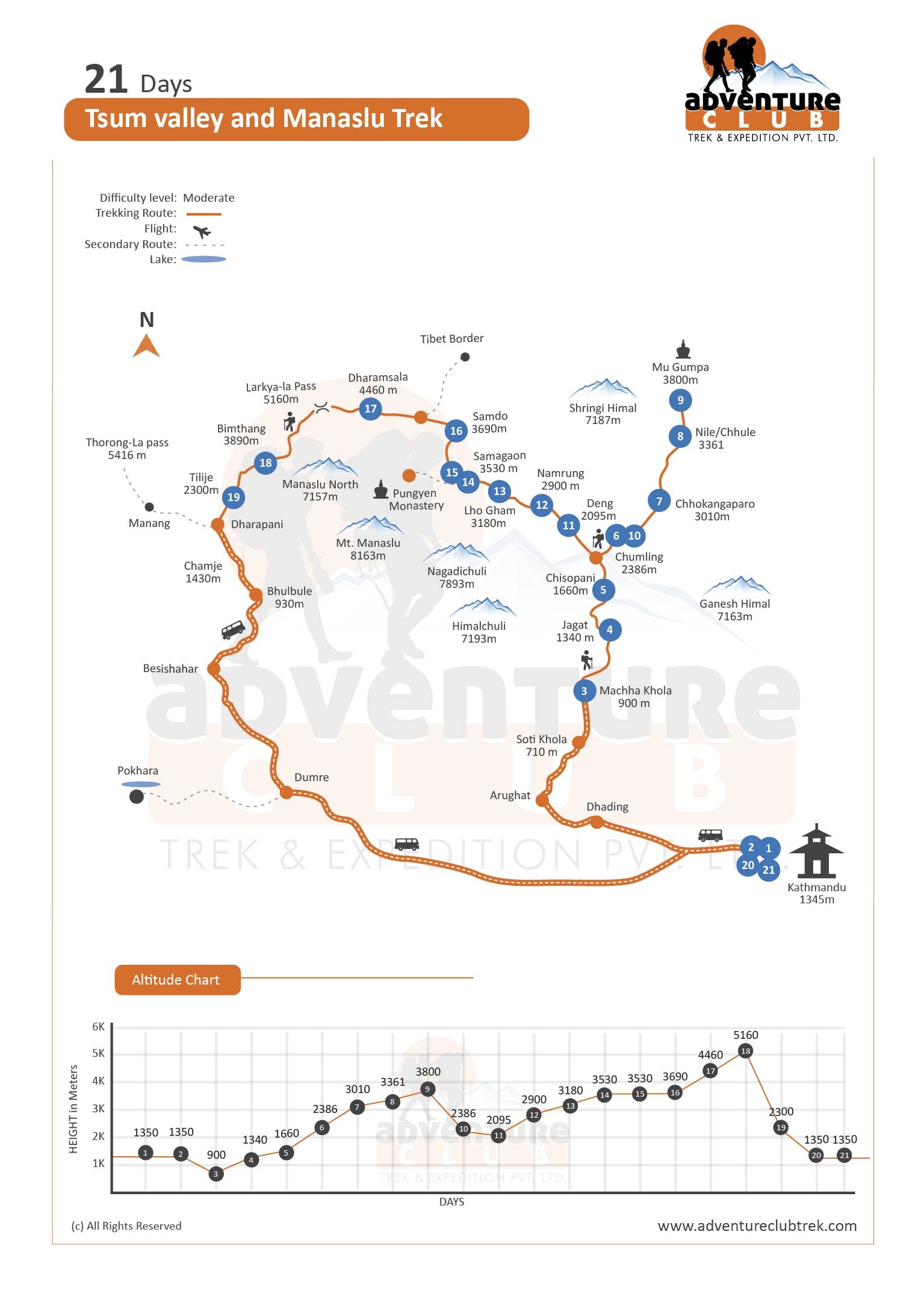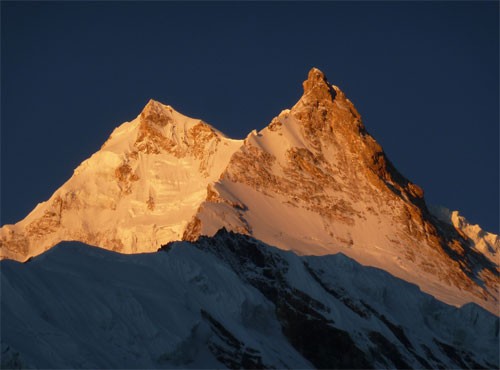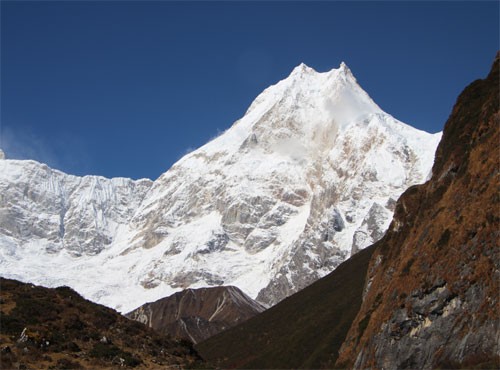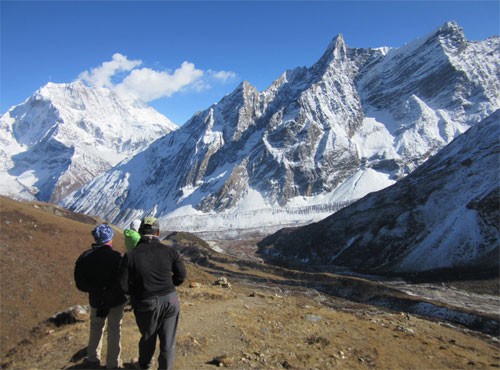Manaslu Circuit & Tsum Valley Trek: A 20-Day Himalayan Adventure
The Manaslu Circuit and Tsum Valley Trek is an extraordinary 20-day journey that takes trekkers through two of Nepal’s most restricted and culturally rich regions—the remote Tsum Valley and the breathtaking Manaslu Circuit Trail. This trek offers an unparalleled opportunity to explore untouched Himalayan landscapes while immersing in the traditional Tibetan Buddhist heritage of the region.
Starting with an 8–9-hour drive from Kathmandu to Soti Khola, the trek gradually ascends through picturesque villages, lush forests, and dramatic gorges. Trekkers first enter the sacred Tsum Valley, a hidden gem known for its unique Tibetan-influenced culture, ancient monasteries like Mu Gompa, and traditional polyandry system. Tsum Valley, being a sacred land, prohibits animal sacrifices, preserving its deep spiritual significance. The trek then rejoins the Manaslu Trail, following the Budi Gandaki River and passing through charming highland villages such as Jagat, Deng, Namrung, Samdo, and Sama Gaun.
A major highlight of this trek is crossing the Larke-La Pass (5,160 m), the highest point of the route, which connects the Budi Gandaki Valley to the Marshyangdi River Valley. This section rewards trekkers with breathtaking panoramic views of Mt. Manaslu (8,156 m), Ganesh Himal, Buddha Himal, Annapurna Range, Hiunchuli, and Larkye Peak. The trail is adorned with glacial moraines, alpine meadows, and frozen lakes, offering an unforgettable Himalayan experience.
This trek offers a deep cultural experience as trekkers encounter Tibetan Buddhist settlements, where locals rely on animal husbandry and traditional farming. The monasteries, chortens, and Mani walls along the trail highlight the deep spiritual connection of the region. Milarepa’s Cave, a sacred meditation site, is another unique attraction. Additionally, the Tsum Valley trek passes close to the Tibetan border, offering a rare chance to interact with Buddhist monks and nuns who live in isolated monasteries.
The trail winds through diverse landscapes, from lush rhododendron forests to rugged rocky paths. Trekkers will witness roaring waterfalls, high-altitude lakes, and long suspension bridges stretching across deep gorges. The Manaslu Conservation Area is home to a variety of wildlife, including the Lophophorus (Nepal’s national bird), Himalayan Thars, blue sheep, and even elusive snow leopards.
The best seasons for the Manaslu Circuit and Tsum Valley Trek are spring (March-April) and autumn (September-November), when the weather is stable, the views are clear, and the trails are vibrant with blooming rhododendrons or golden-hued forests.
Why Choose Adventure Club Trek?
Adventure Club Trek ensures a safe and unforgettable journey with experienced professional guides and porters who are well-versed in high-altitude trekking. Their competitive prices make this adventure accessible while maintaining high service quality. With their deep knowledge of the region, they ensure a smooth and enriching experience, offering insight into both the natural beauty and cultural significance of the area.
The Manaslu Circuit and Tsum Valley Trek is perfect for seasoned trekkers seeking a challenging yet rewarding Himalayan adventure. This trek not only showcases breathtaking mountain landscapes but also offers a glimpse into a centuries-old Tibetan-influenced way of life—making it a truly unique experience in Nepal.
If this itinerary does not meet your needs, we can customize it with extended treks or additional rest days in the Tsum Valley or Manaslu region. This flexibility ensures better altitude adaptation and exploration of key sites like Mu Gompa Monastery. We tailor itineraries to your preferences and adjust pricing accordingly. Feel free to discuss your requirements for a comfortable and fulfilling trekking experience.Trekking Permits for Manaslu Circuit Trek
The government of Nepal has decided to limit tourism in the Manaslu Region, which is the area between Jagat and Dharapani. This means that people who want to trek there alone can't do so. Instead, they need to get a special permit. Also, if you want to trek in this region, you have to be in a group of at least two people with a local guide. You can't just go with any guide; it has to be someone from a registered agency. You'll need three different permits for the Manaslu trek and an extra one if you plan to visit Tsum Valley as well.
Restricted Area Permit for Manaslu and Tsum Valley
The Cost of the Trekking permits
From September to November: USD 100 per person in the first seven nights and USD 15 extra per person each day after the eighth night.
From December to August: USD 75 per person for the initial seven days and USD 10 extra per person each day after the eighth.
The cost of Tsum Valley trekking permits is as follows:
September–November: $40 per person per week, plus $7 per person per day after the first week.
December–August: $30 per person per week, plus $7 per person per day after the first week.
Manaslu Conservation Area Project (MCAP Permit)
This permit is required from Philm, where the Manaslu Conservation Area starts. The price is USD30 year-round for any days you spend inside the conservation area.
Annapurna Conservation Area Project (ACAP Permit)
You will need this permit from Dharapani to exit ACAP at BeshiSahar. The Cost of any day spent in the ACAP conservation zone is USD30.
Meals on Manaslu &Tsum Valley Trek
All meals during the trek—breakfast, lunch, and dinner—are included, while only breakfast is provided in Kathmandu. We also host welcome and farewell dinners for our guests. Meals during the trek include breakfast and dinner at the tea houses or lodges where you stay overnight, and lunch at tea houses along the trail. You can choose from Nepali, Continental, Tibetan, and Indian cuisines. We prioritize healthy, locally sourced, organic food and provide seasonal fruits.
Note: If you're vegetarian, please inform us in advance so we can make proper arrangements for your meals during the trek.
Drinking Water on Manaslu & Tsum Valley Trek
While Adventure Club provides meals, drinking water is not included. It is recommended to treat local water using chlorine/iodine tablets or a steripen. Tea houses provide free water that you can treat, and you can also find water along the trail. Tablets take about 30 minutes to dissolve. You can also buy bottled mineral water on the trek. At lower elevations, it costs around $1 per liter, while at higher elevations, it can cost up to $4.
Accommodations on Manaslu & Tsum Valley Trek
You will stay in a three-star standard hotel in Kathmandu and tea houses/guesthouses during the trek. Since the Manaslu region is a relatively new trekking area, tea house facilities are basic. Accommodations are on a twin-sharing basis, but a single supplement is available for an additional cost.
Electricity, Wi-Fi, and Battery Recharge on the Manaslu Route
Electricity is available at all tea houses where you stay overnight. You can recharge devices like phones and laptops using solar panels or hydroelectricity for a small fee. We recommend bringing extra batteries or a rechargeable power bank as a backup. Wi-Fi is not free along the trail, and cellphone coverage is poor. While some tea houses offer paid Wi-Fi, the connectivity is slow. Carrying a laptop is not advised due to these limitations.

